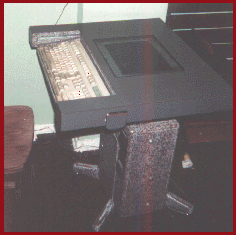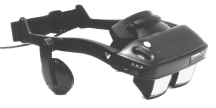"What role does urban planning play in the development of online, multi-user environments and communities?"

"What role does urban planning play in the development of online, multi-user environments and communities?"

Hardware issues with wearable computers.
Wearables require several key peices of expensive hardware. One is the head mounted display system which can cost up to US$500. The next is the single hand held keyboard used to input data. Then the componants of the actual computing box itself have to be assembled. Thad Starner at the MIT Media Lab introduced me to the various devices which go into the construction of his basic wearable computer design, known as the 'Lizzy'.
 |
||
|
Virtua I-O glasses of the sort used by wearable computing researchers at MIT Media Lab and which I bought 2nd hand from a colleague in Melbourne in 1999. The display enables the wearer to see both computer or video at 640 X 480 resolution superimposed over the view of the real world. The unit also delivers stereo audio via the headphones. Most wearable computing users at MIT however use much higher resolution monochrome displays and limit computer interface use to text-driven activity, usually using LINUX operating system. Graphical user interfaces such as the mac or windows are less common. |
I had hoped to construct a Lizzy upon return to Australia from my two month period of study at the MIT Media Lab. Budget constraints prevented this, however a head mounted diplay unit was obtained, and experiments using a apple 'duo 230 powerbook' laptop computer met with partial success at the "I Cubed" complex at RMIT in 1998.
In the video interview I did with Mr Starner in 1998 shown here, he introduces me to some head mounted display options. The first is a personal fax viewer, which can be taken apart and from the unit, the display screen removed and put to use with a custom built dedicated computer. Next is the M1, a more expensive, dedicated off-the-shelf solution to delivering text-quality image to the single eye. "Lizzy" computers are made of small stackable PC104 components which are normally used in vending machines. The design calls for a relatively low end 486 computer as these processors require less cooling than pentium processors. The operating system is the open source LINUX OS. Note Mr Starner wearing his head mounted display around his neck while talking to me.
| Thad Starner shows me an array of monocular head mounted display options and talks about the lifestyle changes which using a wearable entails. June, 1998 MIT Media Lab, Boston (9 minutes, 26 seconds) |
The biggest barrier to full participation in the wearable computing movement for the EMU project was limited funds. In 2001 and 2002 Apple Computer Brisbane contributed a G3 powerbook laptop to my project, and I have been able succesfully with the powerbook and the head mounted display to combine the two, such that I can walk around with the open laptop while simultaneously being online and seeing web sites as I move around. Full control over the laptop is limited, and these experiments can only last as long as the G3 batteries hold out. The process has bee
n valuable however as I now have a good understanding of the relationships between processor speed, the need for portable ongoing use, and the related issues of overheating and the more general issues of being 'at the computer' all day every day.
The Urban Strechnology Kit which I developed along with my partner Molly Hankwitz takes the central theme of mobile media usage and pares it back to small wireless camera equipment and the idea, pioneered by P
rofessor Steven Mann at MIT Media Lab of 'personal imaging'. Where Prof. Mann integrated personal imaging into the processes of wearable computers, I have focussed more on mobile personal wireless analogue video transmission and reception.